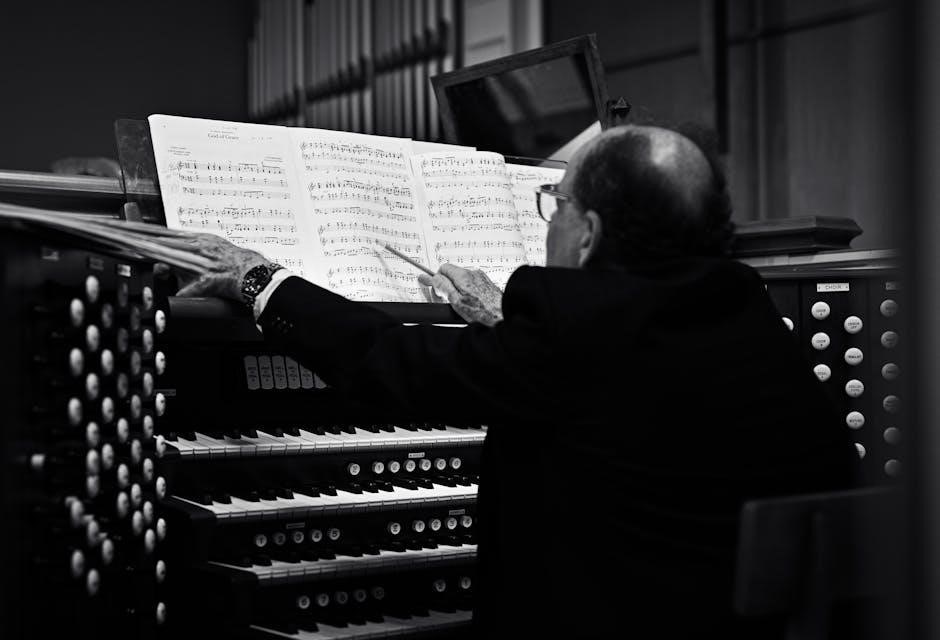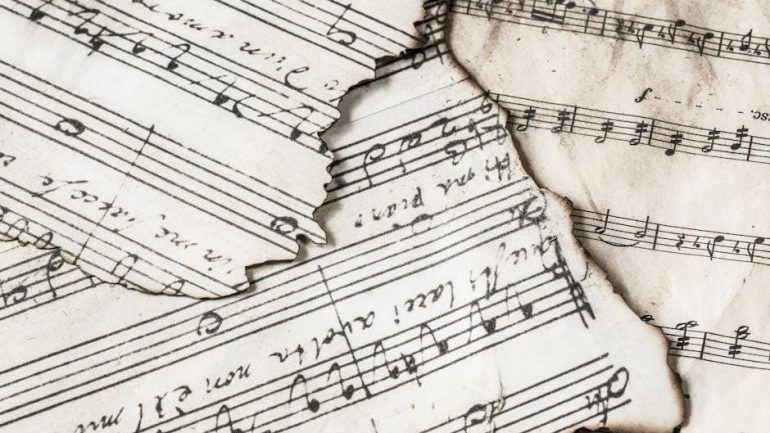The Pathetique Sonata by Beethoven is a masterpiece of emotional depth‚ with its 2nd movement being particularly celebrated for its expressive beauty. This sonata‚ Op.13‚ showcases Beethoven’s innovative spirit. The sheet music for the 2nd movement is widely available in PDF format‚ offering pianists access to this iconic piece.
Overview of Beethoven’s Pathetique Sonata
Beethoven’s Piano Sonata No. 8 in C minor‚ Op. 13‚ commonly known as the Pathetique Sonata‚ is a landmark work in classical music. Composed in 1798‚ it reflects Beethoven’s emerging expressive and innovative style. The sonata consists of three movements‚ with the second movement‚ Adagio cantabile‚ being a serene and lyrical contrast to the dramatic first and third movements. This sonata is notable for its technical challenges and emotional depth‚ making it a favorite among pianists. The sheet music for the 2nd movement is widely available in PDF format‚ allowing musicians to explore and perform this masterpiece. Its cultural significance and enduring popularity highlight Beethoven’s genius;
Significance of the 2nd Movement
The 2nd movement of Beethoven’s Pathetique Sonata holds profound significance due to its serene and lyrical nature‚ contrasting sharply with the dramatic outer movements. Titled Adagio cantabile‚ it offers a moment of reflective calm‚ showcasing Beethoven’s ability to convey deep emotion through simplicity. The movement’s structure‚ unusual for its time‚ features a rondo form‚ which was not typical for second movements in sonatas during Beethoven’s era. Its melodic beauty and technical challenges make it a favorite among pianists. The availability of sheet music in PDF format has further popularized this movement‚ allowing musicians worldwide to study and perform it. This movement remains a testament to Beethoven’s innovative and expressive genius.
Purpose of the Article
This article serves as a comprehensive guide to Beethoven’s Pathetique Sonata‚ focusing on the 2nd movement and its sheet music availability. It aims to provide an in-depth analysis of the sonata’s composition‚ historical context‚ and musical structure‚ while also offering resources for accessing and interpreting the PDF sheet music. The article is designed to cater to pianists‚ music historians‚ and enthusiasts alike‚ offering insights into the significance of the 2nd movement and its enduring impact on classical music. By exploring the Pathetique Sonata in detail‚ this guide seeks to enhance understanding and appreciation of Beethoven’s masterwork.
Composition Details
Beethoven’s Pathetique Sonata (Op.13) is structured in three movements‚ with the 2nd movement being a rondo in A-flat major‚ marked Adagio cantabile. Its composition reflects Beethoven’s early mastery of classical forms‚ blending emotional depth with technical brilliance. The sonata’s key of C minor contributes to its dramatic and expressive nature‚ while the 2nd movement stands out for its lyrical and contemplative qualities‚ showcasing Beethoven’s ability to craft melodies that resonate deeply with listeners. The sheet music for this movement is widely available in PDF format‚ allowing pianists to explore its intricate details and emotional range.
Ludwig van Beethoven as the Composer
Ludwig van Beethoven was a visionary composer whose works transcended classical norms‚ embedding profound emotion and innovation. His Pathetique Sonata (Op.13) exemplifies this‚ showcasing his mastery of piano composition. Beethoven’s early career flourished in Vienna‚ where he gained acclaim for his technical brilliance and expressive depth. The 2nd movement of the sonata‚ marked Adagio cantabile‚ reflects his ability to craft deeply lyrical melodies. Composed in 1798‚ it captures the essence of his early artistic style. Beethoven’s music often explored new territories‚ and the Pathetique Sonata remains a testament to his groundbreaking approach. His compositions continue to inspire pianists worldwide‚ with the sheet music of the 2nd movement readily available for study and performance.
Key and Tempo of the 2nd Movement
The 2nd movement of Beethoven’s Pathetique Sonata is written in the key of A-flat major and marked Adagio cantabile‚ indicating a slow‚ singing tempo. This movement contrasts sharply with the dramatic first movement‚ offering a moment of lyrical reflection. The key of A-flat major contributes to a serene yet introspective mood‚ while the Adagio tempo allows for expressive phrasing. The sheet music highlights Beethoven’s meticulous dynamic and articulation markings‚ essential for capturing the movement’s emotional depth. Pianists must carefully balance the flowing melodies with subtle harmonic shifts to maintain the movement’s dignity and grace. This section remains a cornerstone of Beethoven’s keyboard repertoire‚ showcasing his mastery of contrast and lyrical expression.
Opus Number and Sonata Structure
Beethoven’s Pathetique Sonata is designated as Opus 13‚ a significant work in his early compositional career. The sonata follows a traditional three-movement structure: Grave – Allegro di molto e con brio‚ Adagio cantabile‚ and Rondo: Allegro. This structure adheres to classical sonata form while showcasing Beethoven’s innovative harmonic and emotional depth. The Opus 13 designation highlights its placement within Beethoven’s catalog‚ reflecting his evolving style. The sonata’s dramatic contrasts and cohesive design make it a landmark piece in piano literature‚ exemplifying Beethoven’s mastery of classical forms and his ability to infuse them with profound expressiveness.

Historical Context
Composed in 1798‚ Beethoven’s Pathetique Sonata reflects his emotional turmoil and emerging deafness. It captures the cultural and musical shifts of late 18th-century Vienna‚ blending classical traditions with romantic intensity.
Time Period of Composition
Beethoven composed the Pathetique Sonata in 1798‚ a period marked by personal turmoil and artistic innovation. This was a transitional phase in his career‚ as his hearing loss worsened‚ impacting his identity as a performer. The sonata reflects his emotional struggle‚ blending classical forms with romantic expressiveness. It was written during a time when Vienna‚ the musical capital of Europe‚ was embracing new artistic trends. The 2nd movement‚ with its lyrical grace‚ contrasts sharply with the dramatic first movement‚ showcasing Beethoven’s mastery of dynamic shifts. This piece is a cornerstone of his early romantic style‚ influencing future composers and remaining a staple in piano repertoire.
Dedication of the Sonata
The Pathetique Sonata was dedicated to Beethoven’s patron‚ Prince Joseph Franz von Lobkowitz‚ a prominent supporter of the arts. This dedication reflects Beethoven’s effort to secure financial backing while maintaining artistic independence. The sonata’s emotional intensity resonated deeply with its dedicatee‚ showcasing Beethoven’s ability to convey profound feelings through music. The dedication also symbolizes the shift from patronage to public recognition‚ as Beethoven’s reputation grew. This sonata‚ particularly its 2nd movement‚ became a testament to his innovative style‚ blending classical structure with romantic expression. The dedication to Lobkowitz highlights Beethoven’s strategic balancing of artistic vision and patron expectations.
Cultural Significance in Beethoven’s Era
Beethoven’s Pathetique Sonata emerged during a time of profound cultural shift‚ bridging the Classical and Romantic eras. Its intense emotional depth and technical complexity resonated deeply with audiences‚ reflecting the growing appreciation for expressive art. The sonata’s innovative use of harmony and dynamics set new standards for piano music‚ influencing generations of composers. The 2nd movement‚ with its lyrical and introspective nature‚ became a symbol of Beethoven’s ability to evoke powerful emotions‚ cementing his legacy as a pioneer of Romantic music. This work not only transformed piano repertoire but also mirrored the cultural longing for deeper emotional expression during his time.

Musical Structure
The Pathetique Sonata is structured in three movements‚ each with distinct forms and emotional contrasts. The 2nd movement’s lyrical‚ song-like quality provides a serene interlude between dramatic outer movements.
Overview of the Sonata’s Movements
Beethoven’s Pathetique Sonata is a three-movement piano sonata‚ showcasing a dramatic emotional journey. The first movement‚ marked Grave – Allegro di molto e con brio‚ opens with a solemn introduction followed by a turbulent‚ virtuosic Allegro. The second movement‚ Adagio‚ contrasts with its lyrical‚ melancholic beauty‚ offering a moment of reflection. The third movement‚ Allegro‚ is a lively‚ rhythmic finale that resolves the sonata’s emotional tension. Together‚ these movements create a narrative of struggle‚ introspection‚ and triumph‚ making the Pathetique Sonata one of Beethoven’s most celebrated works. Its structure reflects his innovative approach to sonata form‚ blending tradition with emotional depth and technical brilliance.
Specific Focus on the 2nd Movement
The second movement of Beethoven’s Pathetique Sonata is a deeply expressive Adagio in A-flat major‚ offering a stark contrast to the dramatic first movement. Its lyrical‚ singing melody‚ accompanied by arpeggiated chords‚ creates a sense of introspective calm. The movement’s harmonic richness and melodic simplicity evoke profound emotion‚ with subtle dynamic shifts that guide the listener through a journey of contemplation. This movement is often regarded as one of Beethoven’s most beautiful and touching compositions‚ showcasing his ability to blend simplicity with depth. Its technical demands‚ such as legato phrasing and nuanced pedaling‚ require careful attention‚ making it a beloved yet challenging piece for pianists.
Transition Between Movements
The transitions between movements in Beethoven’s Pathetique Sonata are crafted to emphasize dramatic contrast and emotional continuity. The first movement’s dramatic conclusion leads seamlessly into the second movement’s serene Adagio‚ creating a striking shift in mood. This abrupt yet purposeful transition underscores the emotional depth of the sonata. Similarly‚ the second movement’s delicate ending flows into the third movement’s lively Allegro‚ restoring a sense of energy and resolve. Beethoven’s use of contrasting tempos and dynamics ensures a cohesive narrative flow‚ guiding the listener through a dynamic emotional journey. These transitions highlight Beethoven’s mastery in structuring a sonata that is both unified and dramatically varied‚ reflecting his innovative approach to musical form.

Musical Analysis
The Pathetique Sonata’s second movement is a masterclass in emotional expression‚ with rich thematic development and harmonic complexity. Beethoven’s use of dynamics and phrasing creates profound depth‚ while intricate articulations enhance the movement’s lyrical beauty and dramatic intensity‚ showcasing his innovative approach to musical storytelling.
Thematic Development in the 2nd Movement
The second movement of Beethoven’s Pathetique Sonata is characterized by a lyrical and contemplative theme‚ introduced in the key of A-flat major. The movement begins with a serene‚ hymn-like melody in the right hand‚ accompanied by gentle arpeggios in the left‚ creating a sense of calm. As the movement progresses‚ Beethoven elaborates on this theme through subtle variations‚ introducing secondary motifs that add depth and complexity. The thematic material is fragmented and transformed‚ with dynamic contrasts and harmonic shifts that build tension. This development showcases Beethoven’s mastery of thematic manipulation‚ blending simplicity with dramatic intensity to create a deeply emotional and cohesive musical narrative.
Harmonic and Emotional Depth
The second movement of Beethoven’s Pathetique Sonata exhibits profound harmonic and emotional depth through its intricate use of chord progressions and dynamic contrasts. The movement‚ in A-flat major‚ features unexpected modulations that enhance its expressive qualities. Beethoven’s mastery of harmony is evident in his employment of chromaticism and nuanced key transitions‚ creating a sense of tension and resolution. Emotionally‚ the piece oscillates between serene melodies and dramatic outbursts‚ reflecting Beethoven’s personal struggles. His advancing deafness during composition may have influenced his harmonic choices‚ leading to a visually rich and emotionally intense musical experience. This interplay of harmony and emotion underscores the movement’s enduring impact and beauty.

Use of Dynamics and Articulation
Beethoven’s Pathetique Sonata’s second movement masterfully employs dynamics and articulation to convey emotional intensity. The movement begins with a gentle‚ lyrical theme marked pianissimo‚ showcasing subtle dynamic contrasts. As the piece progresses‚ Beethoven introduces dramatic shifts‚ from soft‚ delicate passages to powerful fortissimo sections‚ creating a sense of dramatic tension. Articulation plays a crucial role‚ with legato phrasing in the melodies and staccato rhythms in the accompaniment‚ adding textural variety. These elements highlight Beethoven’s innovative approach to expressing emotion through sound‚ making the second movement a testament to his compositional genius and emotional depth.

Performance Techniques
Pianists must master phrasing‚ rubato‚ and touch control to convey the lyrical and dramatic contrasts. Expressive pauses and nuanced pedaling enhance the movement’s emotional depth and technical brilliance.

Challenges in Performing the 2nd Movement
Performing the 2nd movement of Beethoven’s Pathetique Sonata presents significant technical and interpretative challenges. The slow‚ lyrical tempo requires precise control to maintain a steady pulse while conveying deep emotion. Pianists must navigate dramatic dynamic contrasts‚ from delicate pianissimos to powerful fortissimos‚ ensuring seamless transitions. Rubato and phrasing demands are stringent‚ as Beethoven’s notation specifies subtle expressive pauses and accelerandos. Additionally‚ the movement’s harmonic complexity and nuanced articulation require meticulous finger dexterity and pedaling techniques. Balancing technical accuracy with emotional depth is paramount‚ as the performer must capture the movement’s tragic beauty and introspective character. Mastery of these elements ensures a compelling interpretation.
Importance of Pedaling in the Movement
Pedaling is crucial in the 2nd movement of Beethoven’s Pathetique Sonata to achieve the desired tonal and emotional effects. The sustain pedal enhances resonance‚ blending notes and creating a sense of continuity‚ particularly in the lyrical melodies. It is essential for maintaining the movement’s introspective and tragic atmosphere. Beethoven did not specify pedal markings‚ so pianists must interpret where to apply sustain‚ sostenuto‚ or una corda pedals. Overuse can obscure articulation‚ while underuse may result in a lack of warmth. Pedaling techniques are vital for balancing clarity and expressiveness‚ ensuring the movement’s dramatic and emotional depth are fully realized. Proper pedaling elevates the performance‚ capturing Beethoven’s intended intensity and beauty.
Expressive Nuances Required
The 2nd movement of Beethoven’s Pathetique Sonata demands exceptional expressive nuance to convey its tragic and introspective character. Pianists must master dynamic contrasts‚ ranging from delicate pianissimos to dramatic fortissimos‚ to capture the emotional intensity. Phrasing and articulation are critical‚ with legato playing essential for lyrical passages and staccato accents adding dramatic tension. Rubato is often applied to emphasize the movement’s tragic elements‚ particularly in the recurring theme. Touch sensitivity is vital to balance power and delicacy‚ ensuring the music breathes with natural expression. These nuances are key to interpreting Beethoven’s dramatic contrasts and emotional depth‚ making the performance deeply moving and authentic. Expressive precision is paramount to honor the composer’s intent and connect with the audience on a profound level.

Sheet Music Availability
The sheet music for Beethoven’s Pathetique Sonata‚ 2nd movement‚ is readily available online in both free and paid versions‚ with many classical music websites offering downloadable PDFs.

Sources for Downloading the PDF
High-quality PDFs of Beethoven’s Pathetique Sonata‚ particularly the 2nd movement‚ can be sourced from reputable websites such as MuseScore‚ IMSLP‚ and classical music archives. These platforms offer free and paid versions‚ ensuring accessibility for both casual enthusiasts and professional musicians. Additionally‚ many educational institutions and libraries provide downloadable sheet music as part of their public domain collections. Retailers like Musicnotes and Sheet Music Plus also offer precise editions‚ often with additional performance notes. When downloading‚ ensure the source is trustworthy to maintain the integrity of Beethoven’s original composition.
Free vs. Paid Versions
Free versions of Beethoven’s Pathetique Sonata 2nd movement PDF are widely available on public domain platforms like IMSLP and MuseScore‚ offering basic sheet music for casual use. However‚ paid versions from sites such as Musicnotes or Sheet Music Plus provide enhanced quality‚ with clearer notation‚ additional performance annotations‚ and sometimes included audio files for reference. Paid editions are ideal for serious musicians seeking precise details‚ while free versions suffice for casual enthusiasts. The choice depends on the user’s needs and commitment to accuracy and depth in their musical study or performance.
Quality and Accuracy of Online Scores
The quality and accuracy of online scores for Beethoven’s Pathetique Sonata 2nd movement vary significantly depending on the source. Reputable platforms like IMSLP and Musicnotes often provide high-quality‚ meticulously transcribed versions‚ adhering to the composer’s original intent. Paid editions typically undergo rigorous proofreading‚ ensuring precise notation and dynamics. Free versions‚ while accessible‚ may lack detail or contain errors due to crowdsourcing. Urtext editions are particularly recommended for their fidelity to Beethoven’s manuscripts. When downloading‚ it’s essential to verify the publisher’s credibility and read user reviews to ensure the score meets musical standards for accurate performance and study.
Cultural Impact
The Pathetique Sonata’s 2nd movement holds profound cultural significance due to its emotional depth and widespread use in film‚ media‚ and inspiration for later composers.
Popularity of the Pathetique Sonata
The Pathetique Sonata remains one of Beethoven’s most celebrated works‚ with its 2nd movement being particularly cherished for its lyrical beauty and emotional intensity. Its widespread popularity stems from its accessibility and universal appeal‚ making it a staple in classical music repertoire. The availability of sheet music PDFs online has further boosted its reach‚ allowing pianists of all levels to engage with the piece. Platforms like MuseScore and IMSLP offer high-quality scores‚ ensuring its enduring presence in both performances and educational settings. This accessibility has cemented its place in cultural consciousness‚ inspiring countless interpretations and adaptations across media and art forms.
Use in Media and Film
Beethoven’s Pathetique Sonata‚ particularly its 2nd movement‚ has been widely featured in media and film to evoke profound emotional resonance. Its hauntingly beautiful melody and expressive depth make it a popular choice for soundtracks. Movies such as The Piano Teacher and The Great Beauty have incorporated the piece to underscore dramatic moments. Additionally‚ it has been used in documentaries‚ commercials‚ and television series to convey introspection and melancholy. The movement’s universal appeal allows it to complement a variety of narratives‚ enhancing emotional impact. Its familiarity also makes it a go-to choice for directors seeking to connect with audiences on a deeper level‚ ensuring its enduring presence in visual storytelling.
Influence on Later Composers
Beethoven’s Pathetique Sonata‚ particularly its 2nd movement‚ profoundly influenced later composers by redefining emotional expression in music. Its dramatic contrasts‚ harmonic richness‚ and thematic development set a new standard for musical storytelling. Composers like Chopin‚ Liszt‚ and Brahms drew inspiration from its emotional depth and structural innovation. The movement’s ability to convey intense personal emotion encouraged later composers to explore similar expressive qualities. Its legacy is evident in the Romantic era’s focus on individuality and dramatic intensity. The Pathetique Sonata remains a cornerstone of classical music‚ shaping the direction of composition and continuing to inspire artists today with its timeless emotional resonance and technical brilliance.
Learning Resources

Discover tutorials‚ practice guides‚ and video performances to master the 2nd movement. Explore recommended editions of the sheet music for accurate study and interpretation.
Tutorials and Practice Guides
Mastering Beethoven’s Pathetique Sonata‚ particularly its 2nd movement‚ requires dedicated practice. Online tutorials offer step-by-step guidance‚ focusing on phrasing‚ dynamics‚ and emotional expression. Video lessons by renowned pianists provide insights into interpreting the movement’s lyrical and dramatic contrasts. Additionally‚ practice guides detail finger exercises‚ pedaling techniques‚ and tempo management. Many resources include downloadable PDF scores with annotations‚ highlighting key sections for focus. Beginners benefit from simplified versions‚ while advanced pianists can explore nuanced interpretations. Forums and communities share tips for overcoming technical challenges‚ ensuring a deeper understanding of Beethoven’s intent. These tools collectively enhance both technical skill and artistic delivery.
Video Performances for Reference
Video performances of Beethoven’s Pathetique Sonata’s 2nd movement are invaluable for pianists seeking to refine their interpretation. Platforms like YouTube and classical music websites host recordings by eminent pianists‚ offering insights into phrasing‚ dynamics‚ and emotional depth. Observing techniques such as finger placement and pedaling provides practical guidance. These performances also highlight the movement’s lyrical and dramatic contrasts‚ aiding in understanding its expressive intent. Comparing interpretations can inspire a deeper appreciation of the piece’s complexity. Such resources are essential for both novice and advanced musicians aiming to capture the essence of Beethoven’s composition in their own performances.
Recommended Editions for Study
For studying Beethoven’s Pathetique Sonata‚ particularly the 2nd movement‚ several editions are highly recommended. The Henle Verlag urtext edition is prized for its accuracy and faithfulness to the original manuscript. Bärenreiter and Peters editions are also excellent‚ offering clear notation and insightful commentary. For students‚ the Schirmer or Kalmus performance editions provide practical fingerings and pedal markings. Many digital versions‚ such as those from Musicnotes or IMSLP‚ offer convenience and accessibility. When selecting an edition‚ consider the expertise of the editor‚ as interpretations can vary. These resources ensure a solid foundation for mastering the movement’s technical and emotional demands.
The Beethoven Pathetique Sonata’s 2nd movement is a deeply expressive piece‚ widely admired for its beauty and emotional resonance. Sheet music for this movement is readily available in PDF format‚ offering pianists access to one of Beethoven’s most cherished works. Sources include reputable online archives‚ libraries‚ and music retailers‚ with both free and paid versions accessible. When selecting a PDF‚ consider the quality and accuracy of the score to ensure fidelity to Beethoven’s original composition. Additionally‚ many resources provide annotations or performance notes‚ aiding musicians in mastering the piece. Whether for study or performance‚ the availability of this sheet music ensures the 2nd movement remains a cornerstone of pianistic repertoire.
Final Thoughts on the 2nd Movement
The 2nd movement of Beethoven’s Pathetique Sonata is a profound expression of emotional depth‚ showcasing the composer’s mastery of melody and harmony. Its beauty and technical demands make it a cornerstone of piano repertoire. Pianists are drawn to its lyrical grace and dramatic contrasts‚ which require precision and sensitivity. Access to high-quality sheet music is essential for accurately interpreting this masterpiece. Whether performing or appreciating‚ the 2nd movement offers a window into Beethoven’s genius. Its enduring popularity reflects its universal appeal‚ making it a timeless work for both artists and audiences. Exploring this movement through sheet music is a rewarding journey into musical excellence.
Encouragement for Further Exploration
Exploring Beethoven’s Pathetique Sonata‚ particularly its 2nd movement‚ is a deeply rewarding experience for musicians and music enthusiasts alike. Delving into the sheet music PDF allows for a closer connection to the composer’s intent and emotional depth. Pianists can benefit from studying various interpretations and practicing the piece to master its technical and expressive challenges. Additionally‚ exploring historical context‚ analyses‚ and performances can enrich one’s understanding. The availability of sheet music online makes it accessible to begin this journey. Embrace the opportunity to immerse yourself in this masterpiece‚ as it offers endless insights into Beethoven’s genius and the world of classical music.



